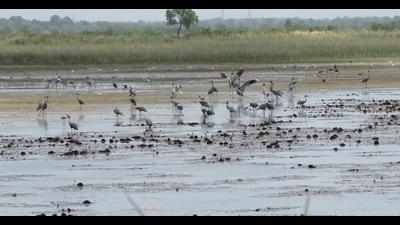- News
- City News
- ahmedabad News
- Gujarat: 10% rise in Sarus crane numbers in Anand, Kheda
Trending
This story is from June 22, 2021
Gujarat: 10% rise in Sarus crane numbers in Anand, Kheda
The annual Sarus crane count on Monday revealed that numbers the threatened Sarus crane in Kheda and Anand District increased by nearly 10%, against the 829 birds counted in 2020.

The Sarus crane count of 2021 was done with the active participation of 35 Rural Sarus Protection Group volunteers, five from Voluntary Nature Conservancy, teachers from various schools, the officials of social forestry division of Nadiad, and other volunteers
AHMEDABAD: The annual Sarus crane count on Monday revealed that numbers the threatened Sarus crane in Kheda and Anand District increased by nearly 10%, against the 829 birds counted in 2020.
The count which is taken up every June revealed that this year the two districts of Kheda and Anand had 915 bird. Apart from this, Sarus are also spotted in Ahmedabad district.
Jitendra Kaur, who was instrumental in forming the Rural Sarus Crane Protection Group, said the result of the count which was revealed on Monday shows that these were the highest numbers since 2015.She said the count is taken up annually in Kheda and Anand districts.
The Sarus crane count of 2021 was done with the active participation of 35 Rural Sarus Protection Group volunteers, five volunteers from Voluntary Nature Conservancy, teachers from various schools, the social forestry division of Nadiad, and other volunteers covering 128 villages in 12 talukas of Kheda and Anand districts.
She said the group has been documenting population, breeding trends and threats to the species in Kheda and Anand districts since 2015. Recently a study by the Salim Ali Centre for Ornithology and Natural History (SACON) revealed that pesticides in fields pose a major threat to the birds by either killing them or affecting their calcium metabolism and making the egg shells very fragile. The study pointed out that chlorpyrifos (one of the most widely used pesticides in agricultural insect control products) showed a strong correlation with eggshell thickness in Ahmedabad, Anand and Kheda districts.
The count which is taken up every June revealed that this year the two districts of Kheda and Anand had 915 bird. Apart from this, Sarus are also spotted in Ahmedabad district.
Jitendra Kaur, who was instrumental in forming the Rural Sarus Crane Protection Group, said the result of the count which was revealed on Monday shows that these were the highest numbers since 2015.She said the count is taken up annually in Kheda and Anand districts.
The Sarus crane count of 2021 was done with the active participation of 35 Rural Sarus Protection Group volunteers, five volunteers from Voluntary Nature Conservancy, teachers from various schools, the social forestry division of Nadiad, and other volunteers covering 128 villages in 12 talukas of Kheda and Anand districts.
She said 89 protection groups, a citizens initiative, in 35 villages of Kheda district are active in protection of the species from egg stealing, nest destruction and poaching. The annual count is held in June as during this period most wetlands and marshes are dry and the cranes can be seen in large congregations at perennial water bodies. The summer congregations help determine the population of Sarus cranes in the region
She said the group has been documenting population, breeding trends and threats to the species in Kheda and Anand districts since 2015. Recently a study by the Salim Ali Centre for Ornithology and Natural History (SACON) revealed that pesticides in fields pose a major threat to the birds by either killing them or affecting their calcium metabolism and making the egg shells very fragile. The study pointed out that chlorpyrifos (one of the most widely used pesticides in agricultural insect control products) showed a strong correlation with eggshell thickness in Ahmedabad, Anand and Kheda districts.
End of Article
FOLLOW US ON SOCIAL MEDIA











